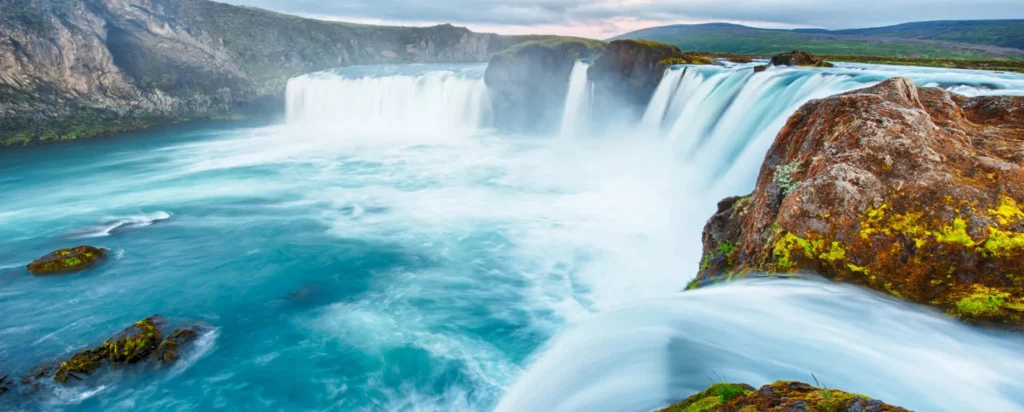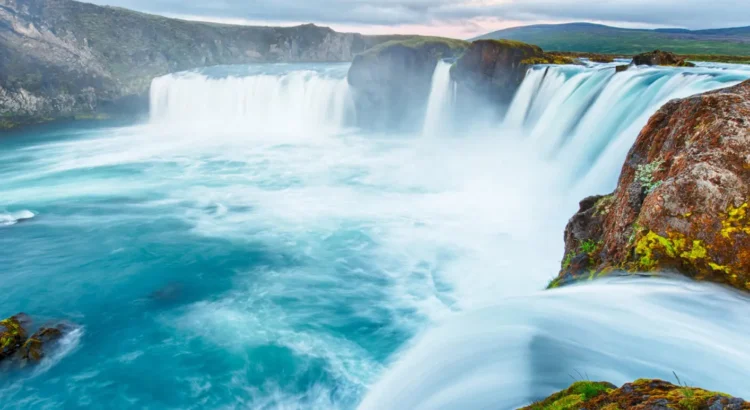
Iceland, a remote North Atlantic island forged by fire and sculpted by ice, is one of the few places on Earth where nature’s raw power is so palpably on display. Here, volcanoes rumble beneath your feet, glaciers gleam like ancient giants, and geysers shoot steam into the cold air like breath from the Earth itself. Known as the “Land of Fire and Ice,” Iceland is a living geological laboratory that invites travelers to witness the elemental forces shaping our planet.
To journey through Iceland is to feel the pulse of the Earth beneath your boots and the silence of pristine wilderness in your soul. Whether you are exploring black-sand beaches, hiking beside melting glaciers, or soaking in hot springs beneath the Northern Lights, Iceland offers a transformative experience unlike any other destination.
A Landscape Born From Fire and Ice
Iceland sits astride the Mid-Atlantic Ridge, where the North American and Eurasian tectonic plates are slowly pulling apart. This unique geological setting creates constant volcanic and geothermal activity, resulting in dramatic terrain that seems plucked from another world. Lava fields stretch for miles like frozen rivers of stone. Snow-capped peaks loom above moss-covered valleys. The land steams, hisses, and sometimes even glows.
And then there’s the ice. Massive glaciers carve their way through the mountains, feeding powerful rivers and crashing into lagoons with thunderous cracks. These glaciers, remnants of the last Ice Age, are some of the largest in Europe and are central to the Icelandic landscape—and psyche.
Reykjavík: A Modern Capital With Ancient Roots
Most adventures in Iceland begin in Reykjavík, the world’s northernmost capital. Though modest in size, Reykjavík is a vibrant city where modern art, music, and design meet Viking heritage and folkloric charm. Colorful houses line quiet streets, geothermal pools offer community gathering spots, and the striking Hallgrímskirkja Church towers like a volcanic spire over the city.
From Reykjavík, you can begin your exploration of Iceland’s iconic natural wonders, many of which lie just a short drive away. Whether you venture out on a day tour or take the ring road around the island, each mile offers a new jaw-dropping vista.
The Golden Circle: A Geothermal Wonderland
The Golden Circle is a popular route that loops through some of Iceland’s most accessible and astonishing sites:
- Þingvellir National Park: A UNESCO World Heritage Site, Þingvellir is where the Icelandic parliament was founded over 1,000 years ago. It also straddles the rift between the Eurasian and North American tectonic plates, visible in dramatic fissures and cliffs.
- Geysir Geothermal Area: Home to the original geyser from which all others get their name, this hot zone is a surreal landscape of bubbling mud pots and steaming vents. The nearby Strokkur Geysir erupts every few minutes, shooting boiling water up to 30 meters in the air.
- Gullfoss Waterfall: One of Iceland’s most iconic waterfalls, Gullfoss (“Golden Falls”) thunders into a rugged canyon, often forming rainbows in the mist. It’s a stunning display of water’s force and grace.
Volcanoes: The Fire Beneath
Volcanic activity is at the heart of Iceland—both figuratively and literally. With over 130 active and dormant volcanoes, Iceland is one of the most volcanically active places on Earth. Eruptions have shaped its terrain and continue to alter it even today.
In 2021, the Fagradalsfjall volcano erupted near Reykjavík, attracting thousands of locals and tourists to witness the awe-inspiring flow of lava. Visiting a volcanic site in Iceland offers a rare chance to observe the Earth creating itself.
Other volcanoes, such as Hekla, Katla, and the infamous Eyjafjallajökull, which disrupted air travel across Europe in 2010, remain powerful reminders of nature’s unpredictability and power.
You can even visit lava tubes, such as Raufarhólshellir, to explore underground caverns formed by flowing magma thousands of years ago.
Glaciers: Ancient Ice And Shimmering Blue
Just as fire defines the Icelandic terrain, so too does ice. Vatnajökull, Europe’s largest glacier, dominates the southeast of the country and feeds numerous outlet glaciers and rivers. Beneath it lie active volcanoes—an extraordinary convergence of fire and ice.
Glacier hiking is a must-do for the adventurous traveler. Guided tours take you onto the ice with crampons and axes, allowing you to explore crevasses, ice caves, and ridges that glitter like frozen cathedrals. The Crystal Ice Cave beneath Vatnajökull is particularly stunning, glowing an otherworldly blue as light filters through solid ice.
Near the glacier, Jökulsárlón Glacier Lagoon is another breathtaking sight. Massive icebergs calve off the glacier’s edge and drift slowly across the lagoon before being carried out to sea. Nearby Diamond Beach, where these icebergs wash ashore on black volcanic sand, looks like a surreal art installation of crystal on obsidian.
Waterfalls, Fjords, and Black Sand Beaches
Iceland’s waterfalls are the stuff of legend—literally. Each has its own story and unique character:
- Seljalandsfoss: A rare waterfall you can walk behind, offering stunning photo opportunities.
- Skógafoss: A 60-meter cascade framed by emerald cliffs and often crowned by rainbows.
- Dettifoss: Europe’s most powerful waterfall, whose roar can be heard before it comes into view.
In the west, the Snæfellsnes Peninsula offers fjords, lava fields, and the legendary Snæfellsjökull glacier-volcano, made famous by Jules Verne’s Journey to the Center of the Earth. The peninsula is often referred to as “Iceland in Miniature” because it contains so many of the country’s signature natural features.
In the south, the black sand beaches of Vík—particularly Reynisfjara—are hauntingly beautiful, with basalt sea stacks rising from the ocean and waves that crash with dangerous force. Legends say the stacks are trolls turned to stone at sunrise.
Northern Lights and Midnight Sun
Depending on when you visit, Iceland offers two of the world’s most extraordinary natural light shows.
In winter, the Aurora Borealis, or Northern Lights, paint the skies in shades of green, pink, and violet. Far from city lights, places like Thingvellir, Lake Mývatn, and Hella offer optimal viewing.
In contrast, summer brings the Midnight Sun, when the sun barely dips below the horizon. This extended daylight turns Iceland into a land of eternal golden hour, perfect for late-night hikes, photography, and marveling at the surreal beauty of sunlit glaciers at 2 a.m.
Geothermal Baths and Hot Springs
Amid all the elemental extremes, Iceland also offers warmth and relaxation in its many geothermal pools. These naturally heated waters are a key part of Icelandic life.
The Blue Lagoon, near the airport, is perhaps the most famous, offering steamy turquoise waters rich in silica and minerals. For a more off-the-beaten-path experience, try Mývatn Nature Baths, Secret Lagoon, or one of the countless “hot pots” scattered throughout the countryside.
Soaking in warm water while surrounded by snowy peaks or fields of lava is one of Iceland’s most memorable experiences—like communing with the very soul of the Earth.
Wildlife Encounters in a Remote Land
Despite its harsh climate, Iceland teems with unique wildlife. Puffins nest on coastal cliffs in the summer, and reindeer roam the eastern fjords. The cold North Atlantic waters around the island are home to seals, dolphins, and whales.
Whale-watching tours from places like Húsavík or Reykjavík offer a chance to see humpbacks, orcas, and even blue whales in their natural habitat. Watching these majestic creatures breach the icy waters is a humbling and unforgettable sight.
Culture Rooted in Nature and Myth
Iceland’s culture is deeply connected to the land. Ancient sagas tell tales of exploration, vengeance, and the supernatural. Belief in elves, or “Huldufólk” (hidden people), is still widespread, and some roads have even been rerouted to avoid disturbing their supposed homes.
The Icelandic language has changed little since the days of the Vikings, and storytelling remains central to Icelandic identity. From literature to music to visual arts, creativity here often reflects the wild beauty and isolation of the island.
And despite its remote location, Iceland is a modern, literate society with a high standard of living, excellent infrastructure, and warm, welcoming people.
Final Thoughts: A Journey to the Edge of the Earth
To discover volcanoes, glaciers, and the raw power of nature in Iceland is to reconnect with the primal forces that shape our world. It is to walk where fire and ice meet, where legends live in the landscape, and where silence is not empty, but full of awe.
In Iceland, you don’t just see the sights—you feel them. You feel the tremor of the earth underfoot, the chill of glacial wind, the warmth of volcanic waters, and the wonder of skies lit by dancing lights.
It’s a journey of contrasts—heat and cold, light and dark, isolation and connection—and one that will leave you changed. In Iceland, nature is not a backdrop—it’s the main character. And if you let it, it will write its story into your soul.




